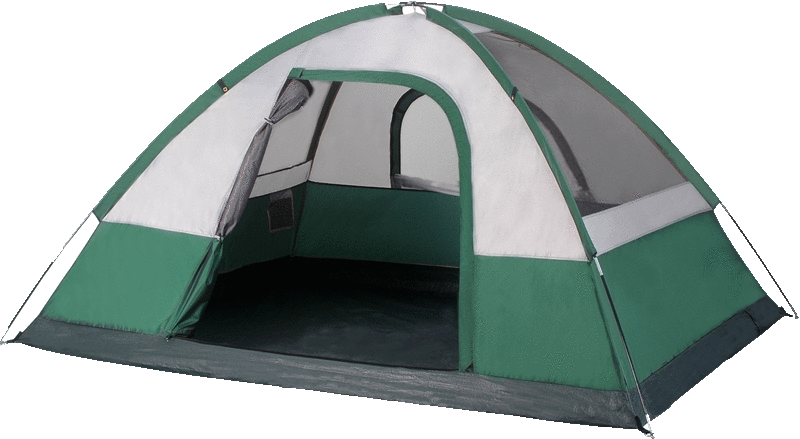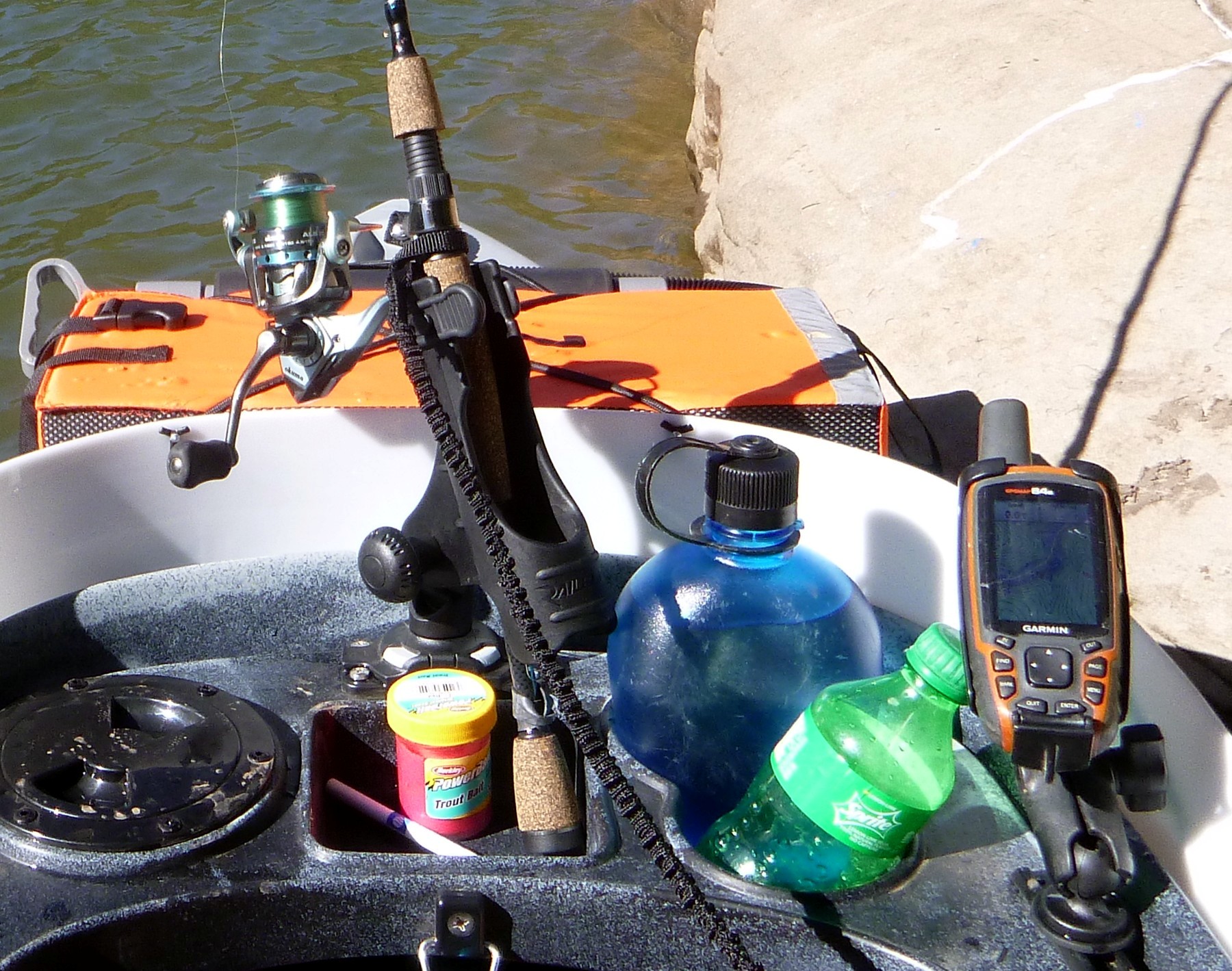I first took up canoeing during my college years. In that time, I became
interested in doing some short course triathlons. These are usually called
sprint triathlons. There could be something like a 5k run, a 20k bicycle stage,
and a 500 meter swim. One triathlon that I participated in at Morro Bay,
substituted canoeing for the normal swim stage. If memory serves, it was about
¾ miles out, then back for a total of 1½ miles. I enlisted the help of a
college buddy as my paddle mate.
The race started with the canoe stage. We were the second boat back by a hair.
Of course I lost all that advantage with my running and cycling stages, but I
had great fun preparing for that race with a borrowed canoe.
Later someone gave me an old aluminum canoe with broken ribs and holes in the
hull. I was in the Air National Guard at that time, so I took it into the sheet
metal shop where one of the experts showed me how to TIG weld aluminum. My
repairs were definitely not pretty, but plenty strong. I enjoyed a number of
years paddling that tank.
One of my buddies here in AZ had rented an aluminum canoe from a rental company
and ended up wrapping it around a tree or a rock on the Verde River. He chose
to replace that rental canoe by purchasing mine from me.
No longer having a canoe now, I went out and bought an Old Town Discovery model
146k sometime in the 90’s. I’ve had it ever since and have used it on a number
of fishing trips, duck hunting, and even javelina hunts. I still have it.
All of that is to say that I have many years of small boat paddling experience,
but all of it in canoes, and all of it in flatwater.
Maybe 6 months ago, my son Ben bought himself a kayak, an Old Town Vapor 10. In
the years that I have been a dedicated canoe captain, kayaks have exploded in
popularity. I never really looked at them because I had the canoe. But the canoe
has problems if I want to get out on the water by myself, rather than with a partner.
First, at 72 pounds, it is rather heavy and size-awkward to handle alone. I can
do it, but it’s not fun. Add to that, I guess that I am starting to enter my senior
years (who ever thought that I would say that?). I have suffered some musculo-skeletal
injuries in recent years with a rotator cuff repair and an ankle rebuild. Maybe I
shouldn’t be trying to man-handle so much weight anymore?
Second, a 14½ foot long canoe is not intended as a solo craft. If I’m sitting at
either end of the canoe, the opposite end rides high. That high side catches the
wind and the canoe becomes difficult to control on the water. There is a thwart
across the gunwales in the middle of the canoe which prevents me from taking a
center seated position.
I will admit right up front that it was not a hunting or fishing application that
pushed me over the edge to purchase a kayak. But now that I have, it has
started to re-kindle my interest in fishing. The reason that I bought it was for
geocaching. There are a number of geocaches on Lake Pleasant and the Rim lakes
that you need a boat to access. A kayak, being relatively inexpensive, easy to
transport, and single person manageable, is the best solution to get to these
geocaches.
The model that I purchased is the Ascend model FS10. Ascend is the Bass Pro/Cabela’s
house brand. The Ascend kayaks are made by their White River Marine Group. This is
a 10 foot long kayak, spec’d to weigh 57 pounds with the chair. But the chair is
removed while transporting, which drops the actual carry weight to 51½ pounds.
There are hundreds of choices for kayaks right now. The FS10 is very much an
entry-level choice, but it has a number of features for fishing, as you would expect
from a company that specializes in the traditional outdoor sports.
Before I get into the details of the FS10, let me provide a little bit of background
on one of the first considerations you will need to make in choosing a kayak for
yourself. I knew the basics before I brought home my kayak, but there was more to
it than I thought. Still, I don’t think that I would have made a different choice
if I would have researched a little more deeply before the purchase.
If you are thinking about getting a kayak, one of the first decisions that you need
to make is whether to focus on sit-inside kayaks or sit-on-top kayaks. I think that
one of the first things that you have to realize with all kayaks, as opposed to
other boats and even canoes, is that you have to expect a somewhat wet ride.
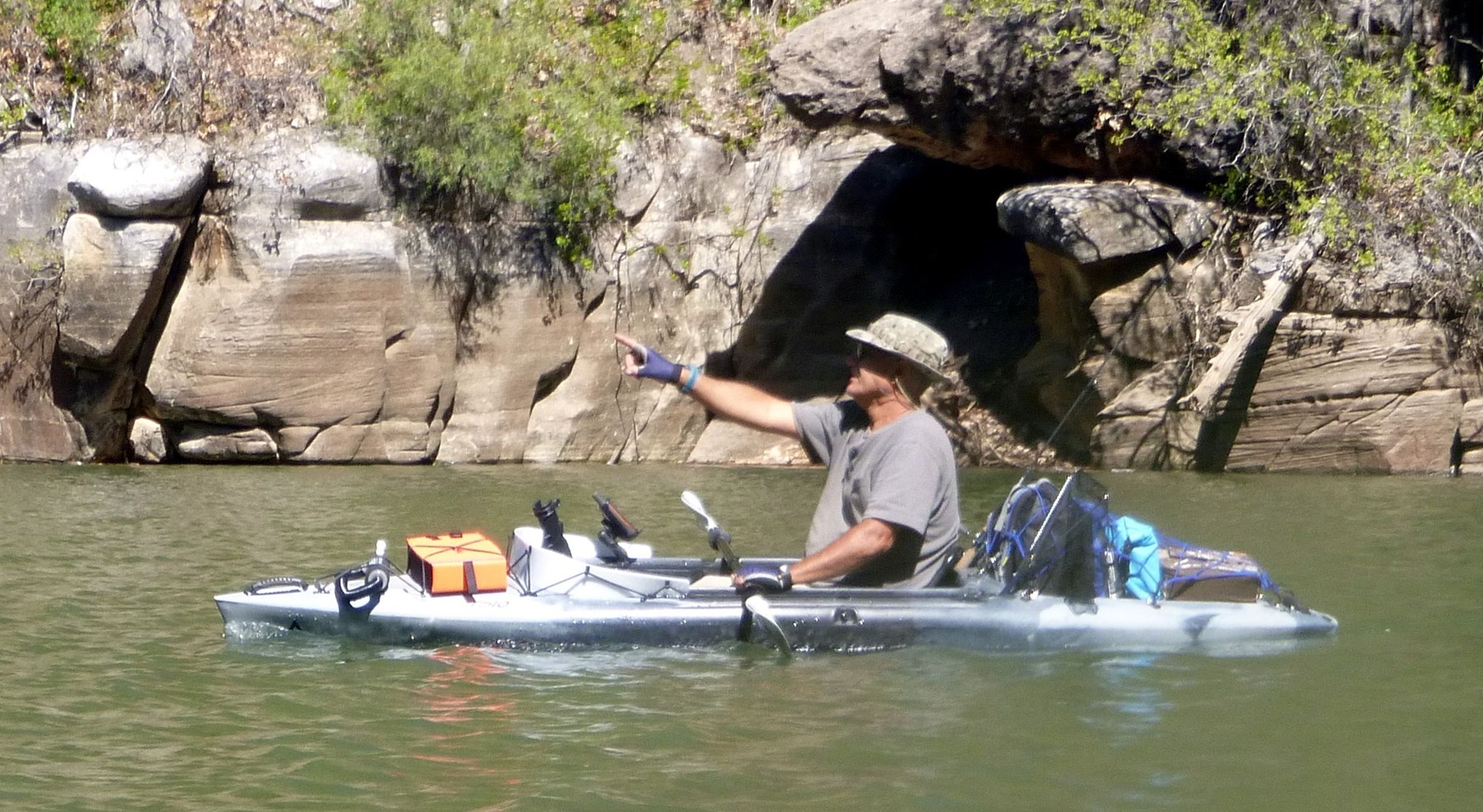
Pointing out a bald eagle on Blue Ridge Reservoir
|
You might stay a little drier in a sit-inside kayak as opposed to a sit-on-top kayak.
I think that was my expectation with the FS10 as it is a sit-inside kayak, but now I’m
not so sure that is true.
Even with a sit-inside kayak, the paddle is constantly bringing dripping water over your
lap. It’s not a lot. Kayak paddles have little rubber rings which are there to
prevent water from dripping down the paddle shaft at you with every stroke, but that
only goes so far.
With a sit-on-top kayak, the craft is basically an enclosed hull with a lot of air
volume, unsinkable. On the other hand, any water that gets in a sit-inside kayak stays
there until you drain it out. Therefore, a sit-on-top kayak is generally considered
safer.
If you should flip a sit-on-top kayak, it is relatively easy to flip it back upright
and wiggle yourself back on top of the deck. Any water that gets in a sit-on-top
kayak will drain out through “scupper” holes. A sit-on-top kayak is generally
considered self-bailing because the deck that you sit/stand on is above the water level.
By contrast, the floor of a sit-inside kayak is below the water line. If you “turtle” a
sit-inside kayak, getting back underway is going to be a great deal more difficult. Most
all sit-inside kayaks will have foam flotation blocks in the bow and stern. I think that
is a Coast Guard requirement for manufacturers to prevent a capsized craft from heading
straight for the bottom.
But when you flip a sit-inside kayak back upright, it will have a heck of a lot of water
inside. With all that water inside, stability will be very much compromised. There
will be a very high probability of reflipping the kayak when you try to jump back in.
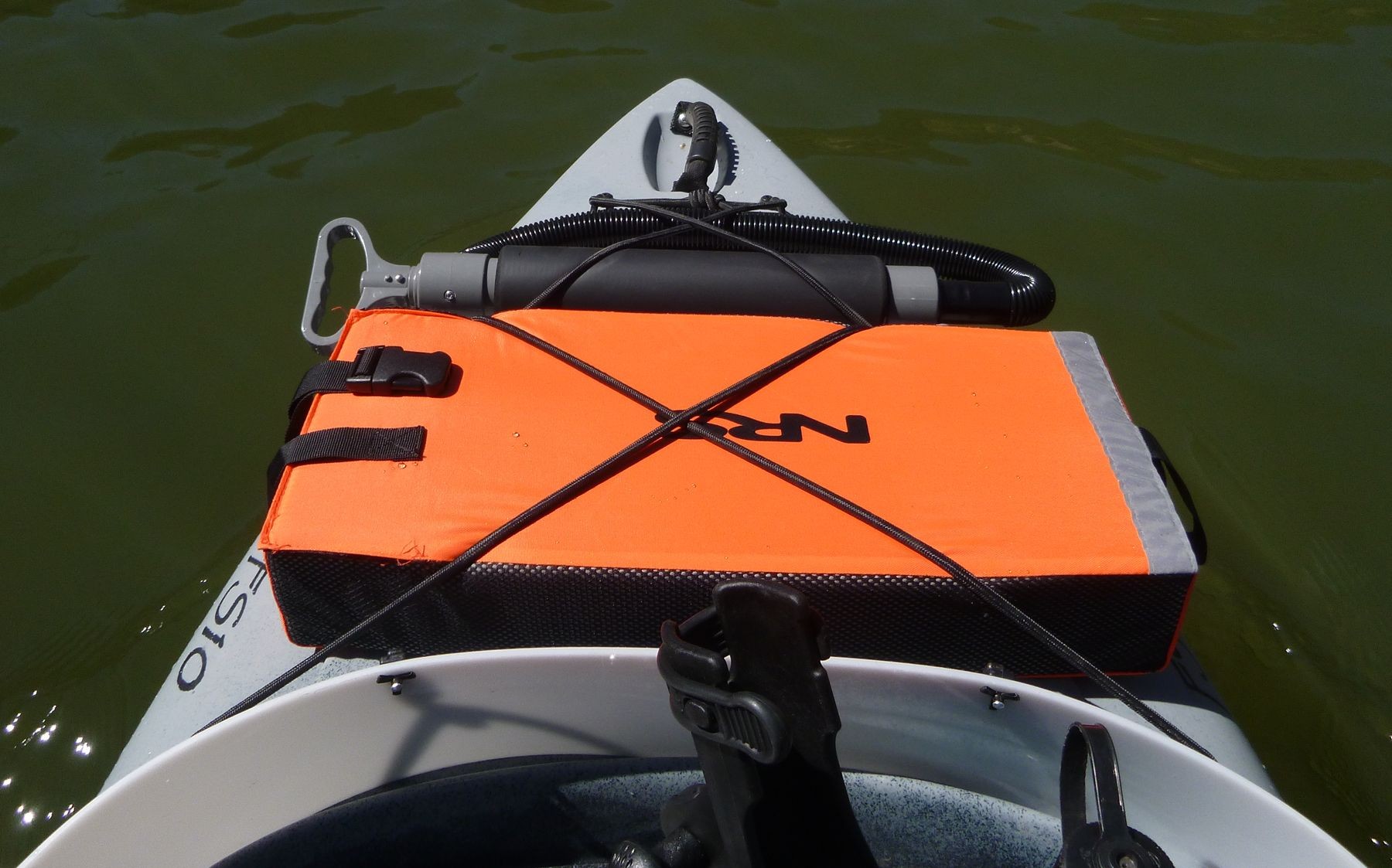
|
The picture above shows two safety devices to help a paddler deal with such a problem.
First, that big orange thing is a paddle float. This paddle float is a large foam
block, but there are also inflatable versions that you have to blow up while you are
in the water next to your swamped boat. Anyway, the paddle float slips over one blade
of your paddle and a strap secures it. You use this as a sort of outrigger to help
stabilize the boat as you attempt to climb back in. You grab the rear edge of the
cockpit with your hand over the paddle handle next to the non-float equipped blade.
This gives you a temporary outrigger. Now kick-swim to get your belly-button over
the stern or rear of the cockpit. Now, still facing down, carefully maneuver your
feet back into the cockpit, then spin over to get your butt back into the seat. Whew!
But now you are sitting in a bath tub. This is where the second safety device
strapped on top of the bow comes into play – the manual bilge pump. Sounds like
fun, eh?
So then why would anyone opt for a sit-in, as opposed to a sit-on-top? My reason
was for paddling efficiency. Sit-ins are generally faster, and being lower, will
not catch as much wind, therefore requiring less course correction. The FS10 is
built with a V-hull in entry and exit, with a fairly flat and broad middle for
stability. Having an optimum fishing platform was not my focus.
Most sit-on-top kayaks are designed primarily with priority on stability. They are
often wider with catamaran or W-shaped hull bottoms. This means a larger wetted
hull surface, and since the boat and the pilot are higher off the surface of the
water, they catch a lot more wind. Sit-on-tops generally are more work to paddle.
With all that said, for the primary purpose of fishing, the market is dominated by
sit-on-tops. This makes sense for a couple of reasons. Sit-on-top fishing kayaks
are designed so that you can stand and sight-cast. Also, if you are trolling from
your kayak, you do not need speed. You need only just enough speed to swim the lure
– 1 to 2 mph.
Many of the more advanced fishing kayaks you don’t even paddle. They may have a
pedal powered propeller, or the Hobie’s actually have pedal-powered flippers
underneath. Old Town just came out with the Sportsman Autopilot models. For a
little under $4000, you can have a kayak equipped with a GPS enabled trolling motor
which can virtually anchor you in place by automatically compensating for drift by
wind and wave, and even take you back to the boat launch or any other place that
you have saved by GPS coordinates, all automatically. All you have to do is sit
back and let the robot motor do all the work. Incredible.
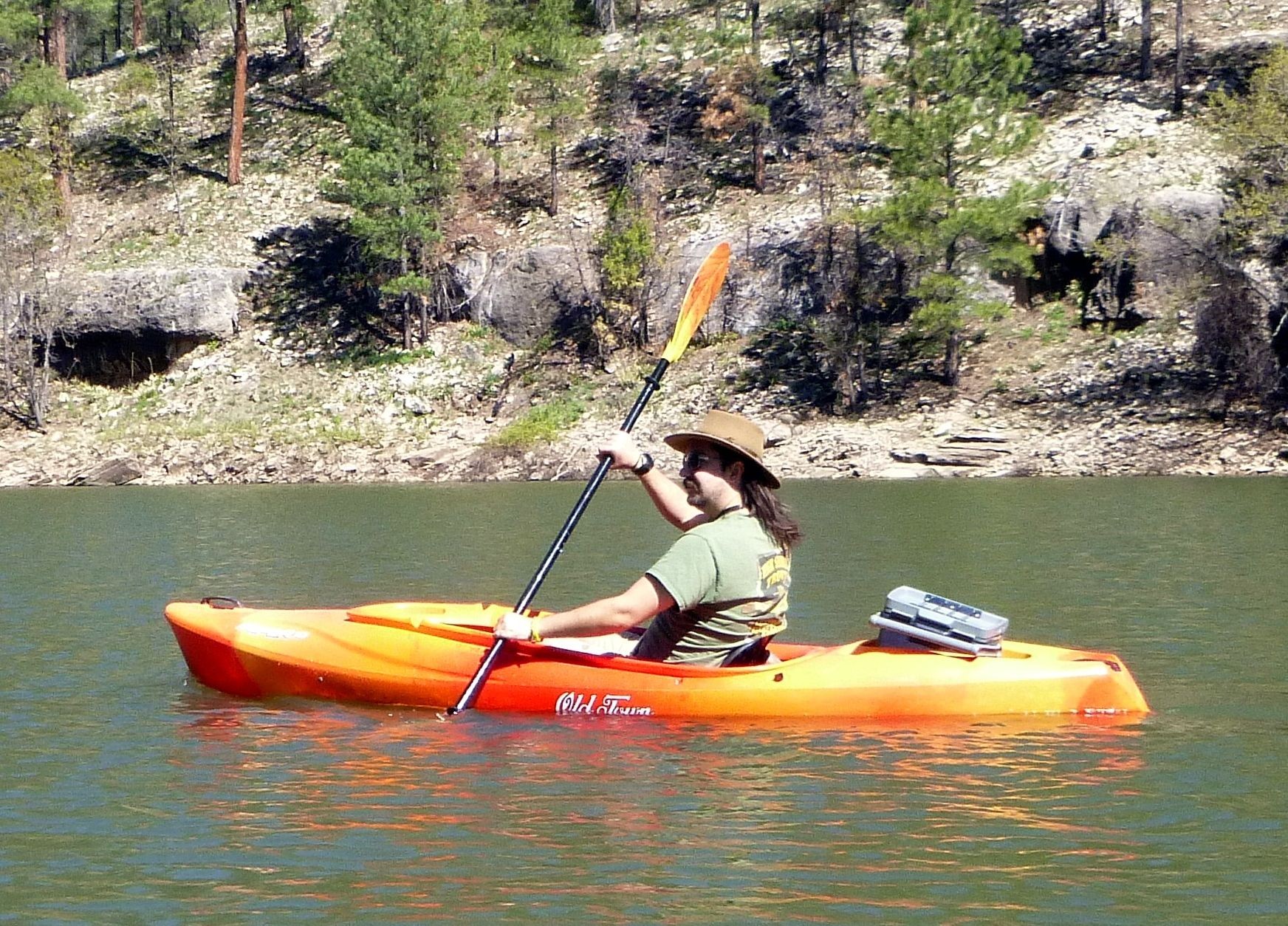
Ben and his Old Town Vapor 10
|
But let’s get back down to Earth with my cheap little Ascend FS10. Cheap? About
$500. There certainly are even cheaper recreational kayaks. Ben’s Old Town Vapor
10 is one of those. Walmart, Costco, and Dick’s (but we don’t shop at Dick’s,
right?) also have a bunch of cheap recreational kayaks by various makers.
The purpose of the common rec kayaks such as the Vapor 10 is just to get out on the
water and have fun. Such kayaks will have very few additional amenities to make
them fit for purpose such as kayak tripping or fishing. For example, the stern
cargo well on Ben’s Vapor is barely big enough to hold his lunch cooler. But just
take a look at the massive stern cargo well on the FS10.
The portion directly behind the seat is designed to accommodate a 13”x13” milk crate.
Apparently, the 13”x13” milk crate has become THE thing that a kayak fisherman must
have on his boat. Guys go all crazy building custom crates for their boats, attaching
PVC pipes to hold additional rods, customizing them with dividers and hanging pockets
to organize their fishing gear, anchor, etc.
Behind the crate section, the FS10’s cargo well accommodates a 5-gallon bucket, the
OTHER highly customizable do-it-all container prized by kayak fishermen. Or if you
don’t need a bucket, this section will also fit a lunch-sized soft cooler even if a
crate fills the forward section. In the world of 10 foot long sit-inside kayaks, you can
think of the FS10 as a pickup truck among sports cars.
Let me make something clear. Any water that may get into the stern cargo well does
not get into the main hull, or bilge of the boat. Any water in the cargo well stays
there. The cargo well is essentially a depression in the top deck. So any waves that
may come over the stern do not risk filling up the hull.
The reason why ample cargo carrying space was important to me was that some of the
geocaches on Blue Ridge Reservoir require paddling out, then hiking, then hanging off
cliffs with rappelling gear. I needed to haul ropes, carabiners, descending equipment,
hiking boots, and my regular adventuring daypack. In the boat, I wear sandals. You’ve
got to expect to get wet feet when getting in and out.
As it comes from the factory, there is a small bungee that criss-crosses only the crate
portion of the cargo well. But to make use of the entire cargo well and secure all that
extra gear packed away in dry bags, I wanted to use a bungee cargo net. To do that I
added a total of seven D-rings on the deck surrounding the well.
You do have to think very carefully about what will happen to everything in your kayak,
should you roll over in the water. Everything that doesn’t float needs to be secured
or it is going to the bottom. Sure the odds of capsizing on any given trip may be low,
but in a kayak, the odds are nowhere near zero.
I added one more D-ring at the front center of the kayak’s “dashboard”. I use this
D-ring to attach a leash to the paddle. Even if the paddle floats, in the event of a
capsize, you don’t want to have to swim away from your boat to chase a drifting paddle.
Speaking of the paddle, on each side of the boat, there is a longitudinal indentation
and a bungee loop for securing your paddle to the side of the boat when you are occupied
with something other than paddling, like fishing!
The first time I took the new kayak out was on Lake Pleasant. If you have never had the
pleasure of piloting a small paddle boat on Lake Pleasant, let me tell you what it is like.
The lake is crawling with high speed bass boats, Jet-Skis, Wave Runners, etc. That means
that you have to fight big wakes all the time. Big wakes crossing other big wakes makes
for a generally choppy surface, even if no boats are near you at the moment.
Take another look at the FS10 in the first two pictures of this story. This little boat
sits very low in the water. The bow and stern are mere inches off the surface. It almost
looks like a submarine. Though this lessens the wind’s tendency to blow you around, this
boat is not very good for high seas at all. That’s its biggest negative point.
The spec’d weight capacity of the boat is 325 pounds. I weigh around 220 to 225, depending
on the day. Yes, the boat will take a good volume of cargo, but you must be mindful of the
total weight of you, plus all the extra crap that you take along with you!
So there I was paddling along … I’ve been out on the lake numerous times in the canoe, so
I knew what to expect. But at one point, a wave came over the bow and water started spilling
over the dash onto my legs. Hmm. There was no sense of panic or anything, just a note to
self, “Hey, there’s water coming in.”
This was a geocache mission. I made it a mile across the water to my target, and a mile back
to the boat launch. Overall it was a successful maiden voyage. But when it came time to
load the boat back on the truck, I was rather surprised by how much water came out of the
drain hole when I turned it over. So right then and there, my expectations about how dry I
was going to stay in my new kayak were reset.
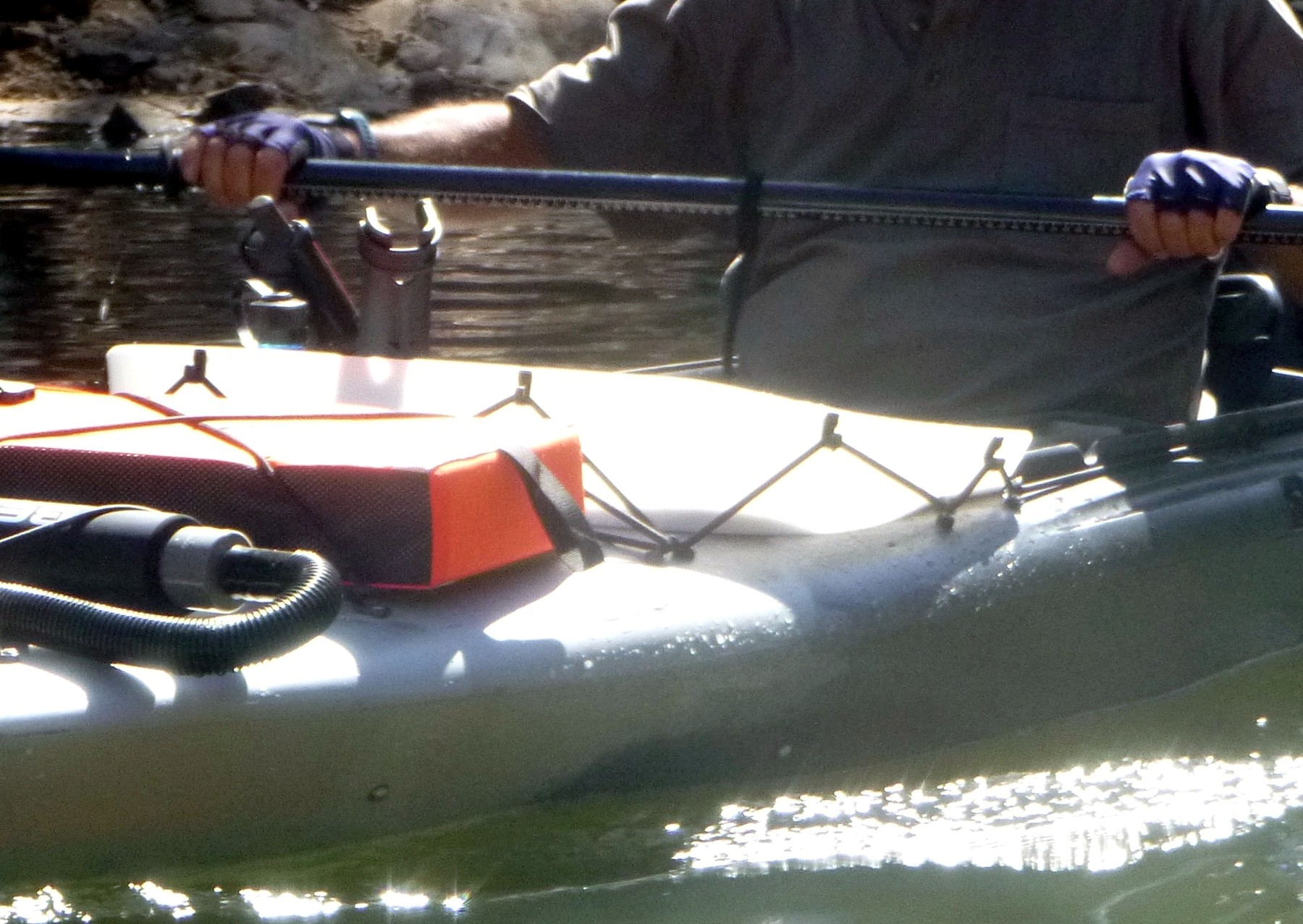
|
Being an inventive kind of guy, I came up with a product improvement idea. That’s what that
white “windshield” is that you see in these photos. Of course it’s not really a windshield,
but a bow wave deflector. It’s just a piece of polyethylene, 48 inches long, 1/8” thick,
four inches tall, tapering down to two inches at the ends. It is held in place with a bungee
cord that I added around the outside perimeter of the cockpit. There are six J-hooks toward
the top edge of the shield. Mounted on the deck around the shield I added a number of so
called “pad-eyes” through which the new bungee is run. The shield is pulled down to the deck
by the bungee. It is quite secure when mounted.
Putting it in place or taking it off can be done in about 30 seconds. It needs to be removed
for transport, as I haul the kayak upside down on the truck.
The kayak comes with two flush mount rod holders behind the seat, set at a rearward 30° angle.
These are perfect for trolling. On the dash, the kayak is equipped with two accessory rails.
I think that they expected folks to add their own rod holder up front mounted on one of the
accessory rails, but I chose to hard mount one front and center by drilling through the dash.
For fishing, I picked up a new long-tail rod. All of the spinning rods that I already owned
had short tails, but the rod holders demand a long tail. By the way, you also want a leash
on your rod in case it goes overboard. The other end of the leash terminates in a mini
carabiner which gets clipped to the cockpit perimeter bungee that I added for the wave shield.
This works great as an attachment point because it allows the leash to travel from front to
rear as necessary. Underway, the rod is in one of the rear rod holders, but if fishing at
anchor, or when I am working with the rod, it goes into the front holder.
As for the accessory rails, I put Ram balls on them. It seems that I have at least one Ram
ball on every vehicle that I own. Of course, this is so that I have a place to mount a GPS.
However, in one of my clumsy dismounts from the boat on a gravel bar, I lost my balance, fell
in the water and in my flailing managed to knock the GPS which broke off the Ram ball attached
to the rail. Fortunately, I had a second ball with me so that I could continue on with the
day’s mission. However, I’ve now decided to hard mount two Ram balls on either side of the
dash. It seems that the rail mount balls are just too fragile.
On the left side of the dash is a waterproof hatch with a vinyl pouch that hangs below the
dash. This is meant for storing things like your wallet, keys, and smart phone, though it
seems to be a tad too short in depth for today’s smart phones.
In the center of the dash is a square cubby molded in as a catch-all place for anything. A
fisherman may make use of this spot for a carton of worms, a jar of Powerbait, or as a
temporary storage spot for swim baits while rigging up.
On the right side of the dash is a unique double compartment cup holder. This cup holder
is a little weird because both portions of it are too large to hold any ordinary cup, and
too shallow to secure any typical bottle or can. However, I found that the larger cavity
is the perfect size to hold a GI style plastic canteen. A canteen wedges in there perfectly.
Additionally, the concave portion of the canteen perfectly complements the second, adjacent
smaller cavity, helping to better corral a standard soft drink bottle or can.
One of the greatest features of the FS10 is the lawn chair style seat. It is quite
comfortable to sit in for extended periods of time. The tilt of the back is adjustable
with a pull strap. It comes out of the boat easily making it useful as a comfortable,
though low shore chair. I’ve used it a couple of times now on shore to eat my lunch. You
can also use it when you park to enjoy some relaxing shore fishing. This type of seat is
a hallmark of today’s fishing kayaks.
Since our club is a Sportsman’s club, not a geocaching club, I should provide some
evidence of the kayak’s actual usefulness for fishing.
After Ben and I found two rappelling caches on Blue Ridge Reservoir, it was time to head
back to the boat launch and then back to camp. We had to go about 1½ miles to get back to
the boat ramp. I decided to do a little trolling on the way back. I put a small spinner
on my line and cast it out. I placed the rod in one of the holders behind me.
The GPS is a great aid in trolling. Not only can you see exactly where you are in this
beautiful flooded canyon, but you can also keep track of your trolling speed. I tried to
keep my speed under 2 mph.
After traveling for at least a half mile, all of a sudden my drag started singing behind
me. As quickly as I could, I spun the boat around to see what was happening. It appeared
that I had snagged on a big log in the last turn of the canyon. I paddled toward the log
while simultaneously trying to reel-in the slack that was now in the line.
Ben beat me to the log and started working on freeing the line. All of a sudden it came
loose and there was a big splash in front of me that threw water in my face. When I
reeled it in there was a pretty little Bluegill on my lure!
Of course I was hoping for an eating sized trout, but I was quite pleased to catch my first
fish from the kayak. Ben and I are hoping to go to Big Lake soon to focus on camping and
fishing instead of geocaching. I will be working with him to install flush mount rod holders
behind his seat to improve his kayak for fishing duty.

![]()
